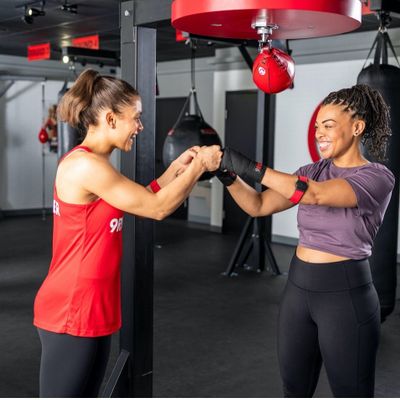How to Find Your Fitness Level

With anything in life, if you don’t know where you’re starting, then it can be nearly impossible to determine a plan to get to where you want to be. This is especially true in fitness when it comes to knowing your current fitness level and creating a routine to meet your goals. Understanding where you’re starting will help you to set realistic expectations and timelines for your specific needs, so we’re sharing four simple ways you can find your fitness level below to help you figure out your starting point for your fitness journey.
Check Your Heart Rate
Monitoring your heart rate during exercise is a great way to keep up with your fitness level and see how you’re improving over time. For example, the first time you worked out at 9Round, your heart rate may have been in the Red Zone for most of your workout, which represents 92 to 100 percent of your max heart rate. It’s okay to be in the Red Zone for short periods of time, but you want to lower your heart rate to 82 to 91 percent of your maximum heart rate for maximum fat burning results – we call this heart rate target the Yellow Zone.
After a few months of working out consistently at 9Round, you should find it easier for you to keep your heart rate in the Yellow Zone more often, which is a clear sign that your fitness level is improving. As you become more fit, it may even become challenging for you to reach the Yellow Zone, and you may need to talk to your 9Round trainer about how you can amp your workouts to make sure you continue reach this ideal fat-burning zone.
Test Your Strength
There are two simple strength tests you can do anytime, anywhere to help you figure out your current fitness level.
The Push-Up Test
The push-up test has been used for many years to test a person’s strength, and it’s a great place to start when assessing your current fitness level. To start your push-up test, you should place your arms shoulder-width apart and assume a standard plank position, or you can do a modified push-up from your knees if necessary.
Bend your arms to a 45-degree angle while keeping your back as neutral as possible in the plank position, keeping your hips in line with your spine as well. The 45-degree angle is considered a standard push-up, but you may need to adjust your push-ups slightly to make things more comfortable for you. This can be done by bringing your arms in closer to your body or spreading them out wider.
Work to complete as many push-ups as you can without stopping and record your total once you’ve reached muscle failure (meaning, you can’t do any more push-ups). Check your total against the recommended amounts recorded below from the Mayo Clinic. If your total is below the target number for your age, then you can use that target as a goal to work toward with your fitness routine.
| Age | Women: number of pushups | Men: number of pushups |
| 25 | 20 | 28 |
| 35 | 19 | 21 |
| 45 | 14 | 16 |
| 55 | 10 | 12 |
| 65 | 10 | 10 |
The Sit-Up Test
A sit-up test is another common method of measuring a person’s strength, particularly in the core. Core strength is important for the rest of our body to function properly, since everything is connected to it, so it’s good to know where you are in terms of core strength with your fitness level. This test is similar to the push-up test above, except you’ll be doing sit-ups for an entire minute and recording your total at the end.
Lie down with your back against the floor, knees bent, and feet flat on the floor. You can have someone help hold down your feet if necessary. Cross your arms in front of your chest so that your pointer fingers are aimed at your ears. Lift your head and shoulders off the ground and curl your upper body up towards your knees, then slowly lower yourself back down.
You should not feel pain in your neck or back during sit-ups if you have the correct form. Focus on using your abs to perform the upward motion and squeezing your stomach muscles as if you’re trying to press your belly button into the ground. If your lower back is having to compensate for a lack of ab work, you may start to feel pain. Luckily, we’ve written a previous blog with more details about this, so take a look if you need some extra help!
Keep count of how many sit-ups you’re able to do in a full minute and record your total. Below are the targets you should aim for based on your age, according to the Mayo Clinic. As with the push-up test, you can use these targets as goals to work toward if you are below the recommended amount.
Remember, as with any goal, consistent practice and work is required to get there, so you’ll need to continue to work on these two exercises to see marked improvement over time!
| Age | Women: number of situps | Men: number of situps |
| 25 | 39 | 44 |
| 35 | 30 | 40 |
| 45 | 25 | 35 |
| 55 | 21 | 30 |
| 65 | 12 | 24 |
Assess Your Flexibility
Your flexibility is another major part of your overall fitness level, and it can be determined with a simple sit and reach test. You probably remember having to do this test in one of your elementary school gymnastics classes, but if not, here’s what you need to do.
Place a yardstick flat against the floor and secure it at the 15-inch mark with a piece of tape. Sit on the floor and stretch your legs out so that your feet are at that 15-inch mark to start. They should be slightly apart, but not more than a foot or so. Lean forward and reach out with your arms as far as you can, then hold the position for at least one second. Repeat this three times and record the best out of three scores you achieved. Use the chart below from the Mayo Clinic to judge your results.
| Age | Women: farthest reach | Men: farthest reach |
| 25 | 21.5 in. (55 cm) | 19.5 in. (50 cm) |
| 35 | 20.5 in. (52 cm) | 18.5 in. (47 cm) |
| 45 | 20.0 in. (51 cm) | 17.5 in. (44 cm) |
| 55 | 19.0 in. (48 cm) | 16.5 in. (42 cm) |
| 6517 | 17.5 in. (44 cm) | 15.5 in. (39 cm) |
Measure Your Body Composition
Knowing your body composition can help you work on building lean muscle, reducing fat, and improving your overall physique. A typical body composition assessment will show you a detailed view of how much muscle and fat content currently make up your body, including detailed measurements of particular areas, such as your waist, hips, arms, and legs.
This shows you exactly where excess fat is stored in your body, so you know what needs to be worked on in order to appear leaner and more toned. Many of our 9Round studios offer body composition measurements with the InBody 270, a professional body composition analyzer that’s relied on by many health and fitness experts. With this technology, we’re able to help our members see how their body changes over time with our KILLER kickboxing workouts.
With these four tests, you can find your fitness level and start setting realistic fitness goals today! Kickstart your new fitness routine with a FREE Introductory Workout at your local 9Round studio. Use the link below to sign-up now, and then get ready to kick it with us during one of our KILLER workouts!


